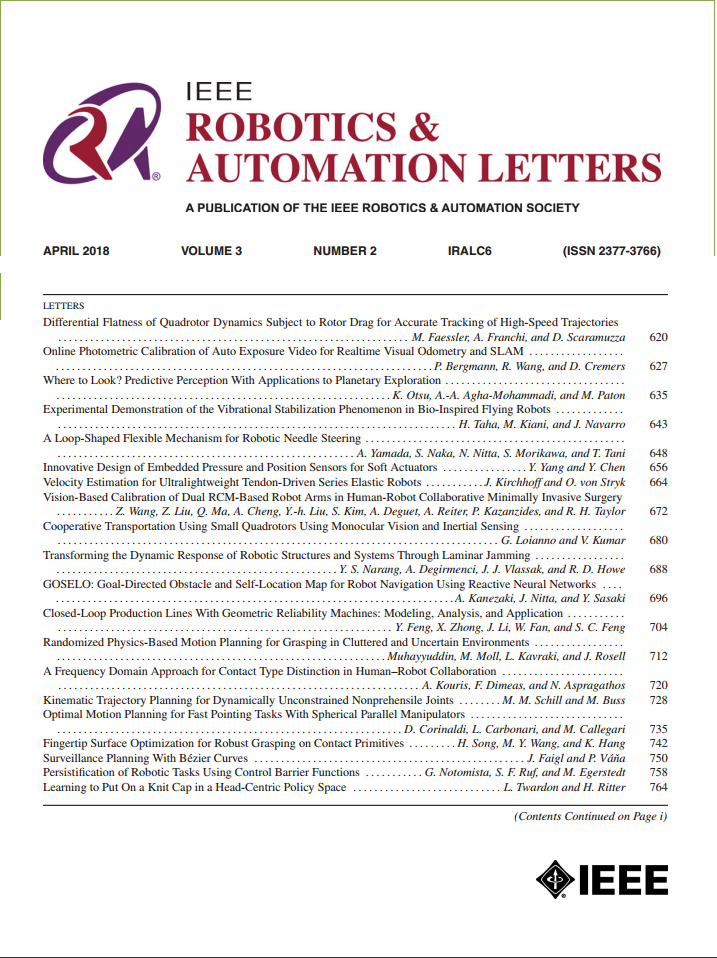语义安全机器人操作:从语义场景理解到运动保障
IF 4.6
2区 计算机科学
Q2 ROBOTICS
引用次数: 0
摘要
在以人为中心的环境中确保安全的交互需要机器人理解并遵守人类公认的“常识”约束(例如,“在笔记本电脑上移动一杯水是不安全的,因为水可能会溢出”或“旋转一杯水是不安全的,因为它可能导致水倒出来”)。计算机视觉和机器学习的最新进展使机器人能够获得对其操作环境的语义理解和推理。虽然存在大量关于安全机器人决策的文献,但语义理解很少集成到这些公式中。在这项工作中,我们提出了一个语义安全过滤器框架,以证明机器人输入相对于语义定义的约束(例如,不安全的空间关系,行为和姿势)和几何定义的约束(例如,环境碰撞和自碰撞约束)。在我们提出的方法中,给定感知输入,我们构建3D环境的语义地图,并利用大型语言模型的上下文推理能力来推断语义不安全的条件。然后,这些语义上不安全的条件通过控制屏障认证公式映射到安全操作。我们在远程操作任务中展示了所提出的语义安全过滤器,并在真实的厨房环境中应用了学习扩散策略,进一步展示了其在解决实际语义安全约束方面的有效性。总之,这些实验突出了我们的方法将语义集成到安全认证中的能力,使机器人的安全操作超越了传统的避碰。本文章由计算机程序翻译,如有差异,请以英文原文为准。
Semantically Safe Robot Manipulation: From Semantic Scene Understanding to Motion Safeguards
Ensuring safe interactions in human-centric environments requires robots to understand and adhere to constraints recognized by humans as “common sense” (e.g., “moving a cup of water above a laptop is unsafe as the water may spill” or “rotating a cup of water is unsafe as it can lead to pouring its content”). Recent advances in computer vision and machine learning have enabled robots to acquire a semantic understanding of and reason about their operating environments. While extensive literature on safe robot decision-making exists, semantic understanding is rarely integrated into these formulations. In this work, we propose a semantic safety filter framework to certify robot inputs with respect to semantically defined constraints (e.g., unsafe spatial relationships, behaviors, and poses) and geometrically defined constraints (e.g., environment-collision and self-collision constraints). In our proposed approach, given perception inputs, we build a semantic map of the 3D environment and leverage the contextual reasoning capabilities of large language models to infer semantically unsafe conditions. These semantically unsafe conditions are then mapped to safe actions through a control barrier certification formulation. We demonstrate the proposed semantic safety filter in teleoperated manipulation tasks and with learned diffusion policies applied in a real-world kitchen environment that further showcases its effectiveness in addressing practical semantic safety constraints. Together, these experiments highlight our approach's capability to integrate semantics into safety certification, enabling safe robot operation beyond traditional collision avoidance.
求助全文
通过发布文献求助,成功后即可免费获取论文全文。
去求助
来源期刊

IEEE Robotics and Automation Letters
Computer Science-Computer Science Applications
CiteScore
9.60
自引率
15.40%
发文量
1428
期刊介绍:
The scope of this journal is to publish peer-reviewed articles that provide a timely and concise account of innovative research ideas and application results, reporting significant theoretical findings and application case studies in areas of robotics and automation.
 求助内容:
求助内容: 应助结果提醒方式:
应助结果提醒方式:


